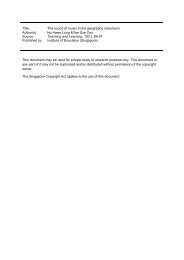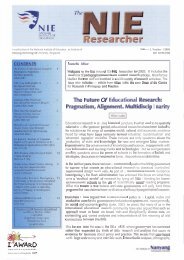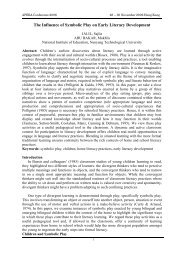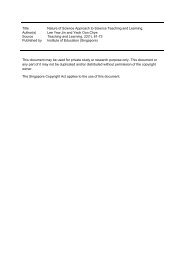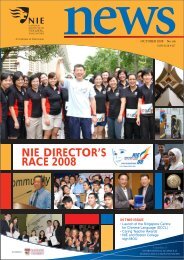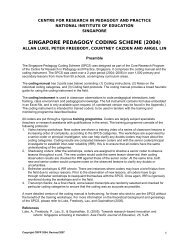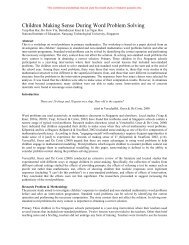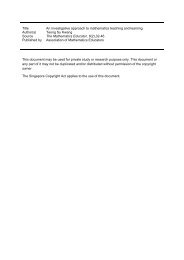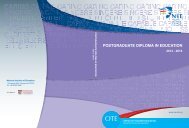Classroom interaction analysis techniques for classroom teachers ...
Classroom interaction analysis techniques for classroom teachers ...
Classroom interaction analysis techniques for classroom teachers ...
Create successful ePaper yourself
Turn your PDF publications into a flip-book with our unique Google optimized e-Paper software.
Redesigning Pedagogy 2011 1BEYOND RESEARCH: CLASSROOM INTERACTION ANALYSIS TECHNIQUES FORCLASSROOM TEACHERSLi LiCRPP-NIE, Nanyang Technological University, SingaporeZhao ShouhuiALC-NIE, Nanyang Technological University, SingaporeChen XinyingCommunication University of ChinaThis research was supported by CRPP project OER08/ZSH.Correspondence concerning this article should be addressed to Dr. Zhao Shouhui, ALC-NIE,Nanyang Technological University, SingaporePaper presented at the 4th Redesigning Pedagogy International ConferenceMay/June 2011, Singapore
Redesigning Pedagogy 2011 2AbstractThis paper explores how research methodologies employed in a large-scale research project can benefit<strong>classroom</strong> <strong>teachers</strong> in helping them self-evaluate and reflect the instructional efficacy of teaching practices.Flanders Interaction Analysis System (FIAS) and Social Network Analysis (SNA) are introduced asalternative methods of research on <strong>classroom</strong> observation as well as the approaches of helping <strong>teachers</strong>conduct self-evaluation and self-improvement.Keywords: Interaction <strong>analysis</strong>, Flanders Interaction Analysis System (FIAS), Social Network Analysis(SNA).
Redesigning Pedagogy 2011 3Beyond Research: <strong>Classroom</strong> Interaction Analysis Techniques <strong>for</strong> <strong>Classroom</strong> TeachersIntroductionThis paper explores how research methodologies employed in a large-scale research projectcan benefit <strong>classroom</strong> <strong>teachers</strong> in helping them self-evaluate and reflect the instructional efficacy ofteaching practices. Specifically, we will introduce two data <strong>analysis</strong> <strong>techniques</strong> of <strong>classroom</strong>pedagogical <strong>interaction</strong> applying to the case studies in a publically funded research project entitled“Effectiveness of the Chinese Modular Curriculum in Singapore Primary Schools – A HolisticEvaluation”. These two <strong>analysis</strong> <strong>techniques</strong> are Flanders Interaction Analysis System (FIAS) andSocial Network Analysis (SNA), both coming along with recommended <strong>analysis</strong> methods that canbe conveniently applied by <strong>teachers</strong> to assist in their per<strong>for</strong>ming the <strong>techniques</strong>. Be<strong>for</strong>e proceedingto elaborate on in which way these two <strong>techniques</strong> can be tapped by <strong>classroom</strong> <strong>teachers</strong> inimproving their instructional practices, a brief introduction is provided in what follows.Flanders Interaction Analysis System (FIAS)Interaction <strong>analysis</strong> has been used to study spontaneous teaching behaviour and it was alsobeen used in projects which attempt to help <strong>teachers</strong> modify their behaviour. Interaction <strong>analysis</strong> inthis paper, among other category systems, mainly focuses on teacher influence in the <strong>classroom</strong>(Amidon, 1966). We introduce one of the earliest <strong>classroom</strong> <strong>interaction</strong>s analysing systems whichinspired many <strong>classroom</strong> analysing systems, especially in the field of <strong>interaction</strong>s in languageclasses (e.g. Spada & Frolich, 1995). Verbal <strong>interaction</strong> between teacher and students in the<strong>classroom</strong> was recorded and analyzed by researchers through FIAS. The assumption is made thatteaching behaviour and pupil response are expressed primarily through the spoken words as a seriesof verbal events which occur one after another (Flanders, 1970). These events are identified, coded,
Redesigning Pedagogy 2011 4so as to preserve sequence, and tabulated systematically in order to represent a sample of thespontaneous teacher influence. In using the FIAS, we tried to provide an answer to the question ofhow a teacher can obtain objective in<strong>for</strong>mation about his <strong>classroom</strong> behaviour, which is rich enoughand clear enough to guide his steps towards self-directed improvement. Teachers may benefit fromthe chance of examining whether the observed in<strong>for</strong>mation is consistent or inconsistent with theirown intentions, and make proper decisions of change afterwards.CategoriesFIAS provides ten categories to classify <strong>classroom</strong> verbal behaviours, as shown in table T1 * .These ten categories classify verbal events in class into three groups, namely, teacher’s talk, studentresponse and the silent moments. The categories of teacher’s talk can also be clustered into twogroups, indirect influence and direct influence, which would partially depict the teaching style of ateacher.Teacher’s talk: indirect influence1. Accept FeelingTeacher accepts and clarifies the feeling tone of the students in a non-threatening manner.Feelings may be positive or negative also includes predicting or recalling feelings.2. Praises or EncouragesTeacher praises or encourages student action or behaviour. Jokes that release tension but notat the expense of another individual, nodding head, or approval are included.3. Accepts or Use Ideas of StudentsTeacher clarifies, builds or develops ideas suggested by a student. As teacher states more ofhis ideas, the category shifts to lecturing.Teacher’s talk: direct influence4. Asks questionsTeacher asks a question about content or procedure with the intent that a student answers.* The number in front of a category is nominal in nature, which represents a classification of event happened during theobservation but not the position on a scale.
5. LecturingRedesigning Pedagogy 2011 5Teacher gives facts or opinions about content or procedures; expresses his ideas, asksrhetorical questions.6. Giving DirectionsTeacher gives directions, commands, or orders to which a student is expect to comply.7. Criticizing or Justifying AuthorityTeacher gives statements which intended to change student behaviour from non –acceptableto acceptable pattern, states teacher authority and so <strong>for</strong>th.Student response:8. Student Talk – ResponseStudents talk in response to teacher. Teacher initiates the contact or solicits studentstatement.9. Student Talk – InitiationStudents initiate the talk, including the response to teacher’s statements which indicates thestudent is willing to talk.Silent moments:10. Silence or ConfusionPauses, short periods of silence and periods of confusion in which communication cannot beunderstood by the observer.Table T1. Categories <strong>for</strong> FIASTeacher Talk Indirect Influence 1. Accept FeelingStudent TalkDirect Influence2. Praises or Encourages3. Accepts or Use Ideas of Students4. Asks questions5. Lecturing6. Giving Directions7. Criticizing or Justifying Authority8. Student talk—Response9. Student talk –Initiation10.Silence or Confusion
Redesigning Pedagogy 2011 6During the class time, trained observer identifies and records the events in class into the aboveten categories. In the original design (Flanders, 1970), the observer should records the verbal eventoccurred into category numbers every three seconds. However, it was reported less applicable totrain a suitable observer. There<strong>for</strong>e, in <strong>classroom</strong> practices, the interval may vary according to theexperience of the observer.Matrix AnalysisAfter <strong>classroom</strong> observation, a series of numbers are produced as the written record whichpreserves the original sequence of events. The number sequence of FIAS is arranged into pairs andtabulated into a matrix <strong>for</strong>mat to facilitate calculation, whereas the outcomes can also be visualizedto explain the results more directly. By highlighting the sequence of verbal behaviours in class,FIAS also provides <strong>teachers</strong> their unique teaching styles from analyzing their verbal reactions tostudents’ speech. It is teacher’s indirect or direct influence which may encourage the <strong>interaction</strong> inclass or, on the contrary, reduce students’ involvements in class.We explain the matrix <strong>analysis</strong> of FIAS through simulated data of <strong>classroom</strong> observationwhich lasts 350 seconds of teaching time. The simulated matrix is showed in table T2. In the table,rows are previous events (categories), while columns are following events. Areas of the matrixindicate different aspects of a teaching procedure.• [Total] The cells in the total row show the percent time the teacher talk, the student talk and thetime in silence. They showed the extent of teacher-student <strong>interaction</strong> and the efficiency of aclass.• [Row 6-7, Column 6-7] indicates the continued use of directions and criticism, which impliesdiscipline problems in the class.• [Row 1-3, Column1-3] indicates the continued use of acceptance and praise, which shows anencouraging teaching style.• [Row 8-9, Column8-9] indicates sustained students participation, which is supposed to be afrequently event in a class with more <strong>interaction</strong>s.
Redesigning Pedagogy 2011 7• [Row 1-7, Column 8-9] indicates the types of teacher statements that trigger studentparticipation, which shows the possibility of gaining students’ attention and involvement.Particularly, [Row4-5, Column 8-9] indicates the response of students towards the instructions;[Row1-3, Column8-9] shows the frequency of teacher encouraging and students responding.• [Row 8-9, Column 1-7] shows the immediate response of the teacher toward the students’ talks,which also indicates the teaching style of a teacher.Table T2. Simulated Matrix AnalysisInteractionMatrixCategory(Formerevent)Category (later event)1 2 3 4 5 6 7 8 9 101 1 0 0 1 1 0 0 0 0 02 0 1 1 0 1 0 0 1 0 03 0 2 5 1 3 0 0 0 1 14 0 0 0 7 0 0 0 6 0 25 1 1 0 2 32 0 1 0 3 16 0 0 0 0 1 0 0 0 0 17 0 0 0 0 0 0 0 0 0 18 1 0 2 2 2 0 0 8 1 09 0 0 4 0 0 0 0 1 3 010 0 0 1 2 1 2 0 0 0 0Total 3 4 13 15 41 2 1 16 8 6Graphic <strong>analysis</strong>Graphic <strong>analysis</strong> is another way to examine the teaching procedure. Since the numberspreserve the original sequence of events, an event map can be produced according to the timeline,which gives a visual impression of teaching procedure. A graph is also convenient to familiarize thepercentage variation of teacher’s talk and students’ talk as the class proceeds, which also describesthe <strong>interaction</strong> activities more directly. Figure Fig.1 shows a scatter chart of the simulated events inthe teaching timeline. According to the density of spots on the fifth category, we have thein<strong>for</strong>mation that Lecturing is the major verbal event during the recorded time slot. The first 60seconds show that the teacher starts the class with asking questions and appraising or encouraging
Redesigning Pedagogy 2011 8the students’ answers. Spots on Line (category) 4, 5, 8 and 9, the teacher asks questions every onceawhile during lecturing and the students always provides short answers, sometimes the students alsoinitiate talks when teacher gives statements.10Category98765432100 30 60 90 12 15 18 210 24 27 30 33Time(S)Fig. 1 Simulated scatter chart of teaching event on the timelineBesides the scatter chart, the comparison of students’ talk with teacher’s talk during the classcan also be visualized with curve chart. The chart tells us when, and then what event, trigger more(or less) verbal participation of students which represents more (or less) student involvement inclass. For instance, Figure Fig.2 shows the accumulation percentage of teacher’s talk and students’talk during the class. The curvature of both curves in the chart shows the increasing pattern ofteacher’s talk and students’ talk. When the students’ talk increases greatly in a very short time span,the teaching events happened be<strong>for</strong>e the time span can be viewed as the inspiring stimulation. Whilethe teacher’s talk increases greatly, the chances <strong>for</strong> students’ expressions are reduced accordingly,which predicts a pattern of less <strong>interaction</strong>s between the teacher and the students.80.0%70.0%60.0%Teacher talkStudent talk50.0%40.0%30.0%20.0%10.0%0.0%0 50 100 150 200 250 300 350Time(S)Fig. 2 Simulated curve chart of teacher talk and student talk percentage
Social Network Analysis(SNA)Redesigning Pedagogy 2011 9SNA is defined as the mapping and measuring of relationships and flows between people,groups, organizations, computers, and other connected in<strong>for</strong>mation/knowledge entities. The nodesin the network are the people and groups while the links show in<strong>for</strong>mation relationships or flowsbetween the nodes. SNA provides both a visual and a mathematical <strong>analysis</strong> of human relationships.The Rationale of SNA Application as a Case StudySNA is becoming increasingly popular as a general methodology <strong>for</strong> understandingcontrollable structures and patterns of <strong>interaction</strong> among actors (i.e., individuals, groups, ororganizations). It describes structures and patterns of relationships between people or social entities,seeks to understand both their causes and consequences. From the network perspective, <strong>teachers</strong>tudent<strong>interaction</strong>s in the <strong>classroom</strong> can be examined as a verbal communication network, in whichspeeches are viewed as connections (or ties) between individual student and the teacher, which areviewed as nodes or vertices in the network. Some underlying characters of the in-class <strong>interaction</strong>scan be acquired through analysing the basic attributes of the network. For example, the degree of acertain vertex (an actor) may indicate the involvement of a certain student. The mathematical root ofnetwork <strong>analysis</strong> permits powerful and well defined manipulations, calculations, as well asvisualizations of social network. SNA technique can be easily applied to analyzing the <strong>classroom</strong>environment with the data acquired from <strong>classroom</strong> observation system. Some of the softwarewhich could per<strong>for</strong>m visualized SNA is also easy to access and master <strong>for</strong> both researchers and<strong>teachers</strong>.NSA approach has been widely used as an effective tool in many research areas. It has beenused in Chinese language studies over recent years (e.g. Liu, 2009) and its potential application inlanguage <strong>classroom</strong> have been recently explored (e.g. Larsen-Freeman & Cameron, 2008, amongothers), but no actual attempts of applying it to Chinese language <strong>classroom</strong> are found in theliterature. Coming to the lesson study carried out by Chinese language researchers at CRPP, in the
Redesigning Pedagogy 2011 10past, a Specific Focus project of a comparative study by using <strong>classroom</strong> observation codingscheme has been completed and the general picture of pedagogical <strong>interaction</strong> in Chinese language<strong>classroom</strong> has been detailed (in <strong>for</strong>m of tabulation and percentage counting) in the findings reportedin both preliminary and final technical reports. Now, policy makers hope to see this kind ofpedagogical <strong>interaction</strong> (both IRF and oral/aural exercise among the learners) in a more detailed andindividual dimension. SNA method provides not only a graphical and intuitive network pictureshowing oral/aural communication patterns and effectiveness occurred in classes, but also acomparative basis to find out the differences and similarities between different modules under thenew modular curriculum launched since 2006 across Singaporean primary education system, aswell as the modular classes (as experimental groups) and the old classes (as control group, throughutilizing the existing CRPP data collected since 2003). Initial literature scan finds that the majormetrics used in SNA are applicable in looking at features of pedagogical <strong>interaction</strong> in language<strong>classroom</strong>. It can be a powerful research approach to visualize <strong>classroom</strong> discourse, thus a goodanswer to key concerns revolving around the effectiveness and efficiency of ef<strong>for</strong>ts committed inimproving students’ oral communicative skills. Given the difficulties and time consuming tocapture the individual speech in a normal <strong>classroom</strong>, the use of SNA approach in <strong>classroom</strong> data<strong>analysis</strong> in current project will be limited to case study.SNA Metrics Applicable in Language Interaction AnalysisAs mentioned earlier, a social network is a social structure made of individuals (ororganizations) called "nodes," which are tied (connected) by one or more specific types ofinterdependency, such as friendship, kinship, financial exchange, dislike, sexual relationships, orrelationships of beliefs, knowledge or even prestige. To understand networks and their participants,researchers evaluate the location of actors in the network. Measuring the network location is findingthe centrality of a node. These measures give us insight into the various roles and groupings in anetwork – who are the connectors, leaders, bridges, isolates, where are the clusters and who is inthem, who is in the core of the network, and who is on the periphery?
Redesigning Pedagogy 2011 11We believe that most of metrics (or measures) used in SNA have implications in analyzinglanguage <strong>interaction</strong> and can be generally fit into <strong>analysis</strong> of efficacy of pedagogical dialogues inoccurring in language <strong>classroom</strong>s. In what follows, to showcase how they can be used <strong>for</strong> analysingcommunicative effectiveness, through using the well known sample (see below) developed byProfessor David Krackhardt (http://www.orgnet.com/sna.html), we attempt to show how some ofmajor SNA metrics can be employed to examine the features and efficacy of language class in lightof oral communicative skills.Fig. 3 Sample of Simulated Network – the“Kite Network”Social network researchers measure network activity <strong>for</strong> a node by using the concept ofdegrees – the number of direct connections a node has (Freeman, 2006). In the above figure, twonodes are connected if they regularly talk to each other, or interact in some ways. Andre regularlyinteracts with Carol, but not with Ike. There<strong>for</strong>e Andre and Carol are connected, but there is no linkdrawn between Andre and Ike. In measure the intensity of language communication, the higherdegree of the link, the more frequent the speakers converse.Degree Centrality. In the network above, Diane has the most direct connections in thenetwork, making hers the most active node in the network. She is a 'connector' or 'hub' in thisnetwork. Common wisdom in personal networks is "the more connections, the better." Whatsignificant, this is not always so. What really matters is where those connections lead to – and howthey connect the otherwise unconnected! Here Diane has connections only to others in herimmediate cluster, known as clique in network <strong>analysis</strong>. She connects only those who are alreadyconnected to each other. In an oral or written communicative environment, she communicates withonly those close to her, so that she can hardly learn anything new linguistically. Suppose Diane is
Redesigning Pedagogy 2011 12the teacher, then the pedagogy is a teacher centred class; but if she is a student, the high degreeindicates that the class might not be dynamic enough, in another words, it is too centralized in termsof opportunity distribution.Betweenness Centrality. While Diane has many direct ties, Heather has few directconnections (3) – fewer than the average in the network. Yet, in many ways, she has one of the bestlocations in the network. She is between two important constituencies. She plays a 'broker' role inthe network, signifying that she plays a powerful role in the network (but she is a single point offailure). Without her, Ike and Jane would be cut off from in<strong>for</strong>mation and knowledge in Diane'scluster. A node with high betweenness has great influence over what flows in the network. A nodelike Heather holds a lot power over the outcomes in a network. In language <strong>classroom</strong>, Heather’language habit should be encouraged, she is not very talkative with the same person, but tries to talkto different persons with the language patterns she has learned from each other, so she is the‘transmitter’ of the new language knowledge.Closeness Centrality. Fernando and Garth have fewer connections than Diane, yet the patternof their direct and indirect ties allow them to access all the nodes in the network more quickly thananyone else. They have the shortest paths to all others, in other words, they are close to everyoneelse. They are in an excellent position to monitor the in<strong>for</strong>mation flow in the network, i.e., theyhave the best visibility into what is happening in the network. There<strong>for</strong>e, Fernando and Garth’sbehaviours are also ideal in terms of language learning, they learn most from others, and vice versa.For instance, their vocabulary is rich and they intend to be exposed to wide variety of structuralpatterns of the target language.Network Centralization. Individual network centralities provide insight into the individual'slocation in the network. The relationship between the centralities of all nodes can reveal much aboutthe overall network structure. A very centralized network is dominated by one or a few very central
Redesigning Pedagogy 2011 13nodes. In language <strong>classroom</strong>, this kind of classes is dominated by fewer students, or more likely, isa teacher-centred class, and students have few opportunities to communicate with other freely.Boundary Spanners. Nodes that connect their group to others usually end up with highnetwork metrics. Boundary spanners such as Fernando, Garth, and Heather are more central in theoverall network than their immediate neighbours whose connections are only local, within theirimmediate cluster. One can be a boundary spanner via one’s bridging connections to other clustersor via one’s concurrent membership in overlapping groups. Boundary spanners are well-positionedto be innovators, since they have access to ideas and in<strong>for</strong>mation flowing in other clusters. They arenormally active in the language learning environment and spread the new words and expressions.They are good language learners and also play a positive role in oral communication.Peripheral Players. Most people would view the nodes on the periphery of a network as notbeing very important. In fact, Ike and Jane receive very low centrality scores <strong>for</strong> this network. Sinceindividuals' networks overlap, peripheral nodes are connected to networks that are not currentlymapped. Ike and Jane may be students that have their own small group of friends outside of thebigger language <strong>classroom</strong> or community, thus making them very important resources <strong>for</strong> freshlanguage usages not available inside the bigger unit.The resulting graph-based structures are often very complex. There can be many kinds of tiesbetween the nodes. Research in a number of academic fields has shown that social networks operateon many levels, from families up to the level of nations, and play a critical role in determining theway problems are solved. Rather than what described above, some other measures that are oftenmentioned in SNA and relevant to language acquisition are: average degree, path length,eigenvector centrality, hierarchical organization, radiality, weak/strong link (see, e.g. Scott, 1991;Wasserman & Faust, 1994).Tentative Summary
Redesigning Pedagogy 2011 14Constrained by the space limits, what described here provides only a brief description aboutthe major SNA measures and the way how they can be applied in examining language <strong>interaction</strong> interm of acquisition efficacy. We admit that a number of technical issues need further elaborationbe<strong>for</strong>e teacher can make better use of them to evaluate their <strong>classroom</strong> practices. Obviously, likeany initiative in educational innovation, new technology introduction invariably requires extracommitment from <strong>teachers</strong>. There are cases where <strong>teachers</strong> are not always be able to generate anactual network graph, the SNA may after all be adopted as alternative perspective <strong>for</strong> <strong>classroom</strong>practitioners to gauge their teaching results. If <strong>teachers</strong> and students are regarded as the node, andspeech action measured by either dialogue duration or turns (e.g. Initiate-Respond-Feedback, e.g.,IRF) as the link value, taking into account other influential factors such as family languagebackground, four network graphs can be generated as shown in the Appendix.ConclusionPeople involved in educational research are discontent about the separateness of the researchand practice communities, the limited relevance of educational research, the failure to articulatemanageable research-validated interventions, and the weak opportunities <strong>for</strong> professionaldevelopment. These are also among the primary reasons that explain the current gap betweenresearch and practice in Singaporean context. To avoid the disengagement characterized by doneand-runaway that seen in most research projects, the possibilities of making the research morerelevant that can have actual impacts on <strong>teachers</strong>’ <strong>classroom</strong> practises waw keenly explored incourse of project implementation. A major research methodology of the project is <strong>classroom</strong>observation, which examines what happens in the <strong>classroom</strong> <strong>for</strong> the <strong>analysis</strong> of teacher-student<strong>interaction</strong>. The <strong>techniques</strong> in our case studies enable us to analyze the same class from other angles,which may also enlighten the <strong>teachers</strong> to their teaching with alternative methods.The teaching-learning situation in the <strong>classroom</strong> involves <strong>interaction</strong> between the teacher andthe student. The success of a teacher may be judged through the degree of effectiveness of histeaching which may be objectively assessed through his <strong>classroom</strong> behavior or <strong>interaction</strong>. Thus a
Redesigning Pedagogy 2011 15systematic or objective <strong>analysis</strong> of the teacher’s <strong>classroom</strong> <strong>interaction</strong> may provide a reliableassessment of what goes on inside the <strong>classroom</strong> in terms of teaching and learning. Given theintensive human power and time consumption to conduct data processing and annotation which arerequired in order to generate the graphic illustration, it might be unrealistic to expect a <strong>classroom</strong>teacher to use the complex <strong>classroom</strong> <strong>interaction</strong> <strong>analysis</strong> <strong>techniques</strong> without external input.However, it is worth arguing that to have a good understanding of some basic concepts willundoubtedly enable the <strong>teachers</strong> to have an alternative dimension to look at their teaching practices.The two approaches introduced in this paper are advantageous because that, on the one hand, it isstraight<strong>for</strong>ward and intuitive, more significantly, they reveal the covered pitfall that otherwise maynot be realized by <strong>classroom</strong> <strong>teachers</strong>, namely, being contrastive to traditional stereotype, to remind<strong>teachers</strong> to give more attention to the marginalized silent students who are normally not the centreof the <strong>classroom</strong>, but may have special contribution in terms of new vocabulary or expressionintroduction.We believe that there are two <strong>for</strong>ms of research on practice: <strong>for</strong>mal research and practicalinquiry. Formal research is undertaken by researchers and practitioners to contribute to anestablished and general knowledge base. Practical inquiry is undertaken by practitioners to improvetheir practice. It is suggested that practical inquiry is more likely than <strong>for</strong>mal research to lead toimmediate <strong>classroom</strong> change; that these two <strong>for</strong>ms of research are fundamentally different; and thatboth are useful to practice, but in different ways. There<strong>for</strong>e, in carrying out the <strong>for</strong>mal research,beyond <strong>for</strong>mal discoveries and new knowledge that can in<strong>for</strong>m research community and policymakers,the research team has endeavoured to trans<strong>for</strong>m the a<strong>for</strong>ementioned researchmethodologies into a part of routine practices enabling <strong>teachers</strong> to improve instruction on individualbasis. It is our hope that the intention of bridging the gap between the <strong>for</strong>mal research and practicalinquiry will be one of the focuses in project implementation agenda, a unique offer that prevailingresearch practices have not provided, or cannot provide <strong>for</strong> education community.
Redesigning Pedagogy 2011 16ReferencesAmidon, E. J. & Hough, J. B. (1966). Improving Teaching: The Analysis of <strong>Classroom</strong> Verbal Interaction.New York: Holt, Rinehart and Winston.Amidon, E. J. & Flanders, N. A. (1971). The Role of the Teacher in the <strong>Classroom</strong> (Revised Edition).Minneapolis: Association <strong>for</strong> Productive Teaching.Flanders, N. A. ( 1970). Analyzing Teacher Behaviour. London: Harper and Row.Freeman, L. (2006). The Development of Social Network Analysis. Vancouver: Empirical Press.Larsen-Freeman, D. & Cameron, L. (2008). Complex System and Applied Linguistics. Ox<strong>for</strong>d: Ox<strong>for</strong>dUniversity Press.Liu, H. T. (2009). Probability Distribution of dependencies based on a Chinese Dependency Treebank.Journal of Quantitative Linguistics 16 (3): 256-273.Scott, J. (1991). Social Network Analysis. London: Sage.Spada, N. & Fröhlich, M. (1995). COLT: Communicative Orientation of Language Teaching ObservationScheme: Coding conventions and applications, Sydney: NCELTR, Macquarie University.Wasserman, S. & Faust, K. (1994). Social Network Analysis: Methods and Applications. Cambridge:Cambridge University Press.
AppendixRedesigning Pedagogy 2011 17Simulated Network of <strong>Classroom</strong> InteractionFig. 1: Simple Network-Imagined Network of <strong>Classroom</strong> Interaction without Direction(Node = teacher + student; Line = <strong>interaction</strong> between teacher and students and among students)Fig. 1: Network Showing Dialogue Initiation Direction
Redesigning Pedagogy 2011 18Fig. 2: Network with Directions and Link Value (Unit: minute) Showing Interaction Duration(The entire class activities last <strong>for</strong> 20 minutes; the value between the students indicates the total <strong>interaction</strong> time)Fig. 3: Network with Differentiation of Family Language Background(Yellow = Teacher, Red = Students from Chinese predominant family, Green = Students from English predominantFamily; Blue = Students from bilingual family)



